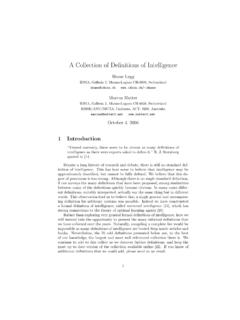Transcription of Designing and Developing Video Lessons for Online ... - ed
1 Designing and Developing Video Lessons for Online Learning: A Seven-Principle Model Online Learning Journal Volume 23 Issue 2 June 2019 5 82 Designing and Developing Video Lessons for Online Learning: A Seven-Principle Model Chaohua Ou, David A. Joyner, and Ashok K. Goel Georgia Institute of Technology Abstract Despite the ubiquitous use of instructional videos in both formal and informal learning settings, questions remain largely unanswered on how to design and develop Video Lessons that are often used as the primary method for delivering instruction in Online courses.
2 In this study, we experimented with a model of seven principles drawn from instructional design theories for Designing and Developing Video Lessons for an Online graduate course. Feedback was collected from students through surveys on their perceptions of the effectiveness of the Video Lessons and the overall course quality for eight semesters. This paper shares the instructors experience on the design and development of the Video Lessons as well as the survey findings. Implications of the findings for instructional design and future research are also discussed.
3 Keywords: artificial intelligence, instructional videos, Online learning Ou, C., Joyner, , & Goel, (2019). Designing and Developing Video Lessons for Online learning: A seven-principle model. Online Learning, 23(2), 82-104. Designing and Developing Video Lessons for Online Learning: A Seven-Principle Model Online education provided underserved students with increased access to education, and enrollments in Online courses increased for the 14th straight year in 2016 (Seaman, Allen, & Seaman, 2018). The rapid growth of Online education has resulted in increasing interest in research on learning with instructional Video (Poquet, Lim, Mirriahi, & Dawson, 2018).
4 In Online courses, especially massive open Online courses (MOOCs), Video is often the primary method for delivering instruction (Hansch et al., 2015; Hollands & Tirthali, 2014; Means, Toyama, Murphy, Bakia, & Jones, 2009). Therefore, instructional Video plays a significant role in Online learners learning experiences. The widespread use of Video in education during the past decade was made possible by the ready-to-use camera available in mobile devices, free streaming media hosting and sharing platforms, and recording studios available on many campuses.
5 The rapid advancement of Video technologies has made available a large variety of design options. According to Hansch et al. (2015), there are nine types of instructional videos, when defined by their affordances of learning, and there are 18 Video production styles. Since courses vary greatly regarding subject matter, learning goals and objectives, and students, instructors have to make deliberate decisions on selecting and leveraging the most appropriate available technologies and resources to create videos that help students achieve desired learning outcomes.
6 Hence, there is a growing need to develop Designing and Developing Video Lessons for Online Learning: A Seven-Principle Model Online Learning Journal Volume 23 Issue 2 June 2019 5 83 research-based principles for Designing instructional videos to support learning (De Koning, Hoogerheide, & Boucheix, 2018; Hansch et al., 2015; Kay, 2012; Poquet et al., 2018). Many of the research studies on instructional Video draw heavily on instructional design theories, such as the cognitive theory of multimedia learning (Mayer, 2009) and cognitive load theory (Sweller, 1988), as a general framework for design considerations (Fiorella & Mayer, 2018; Poquet et al.)
7 , 2018). These studies have primarily focused on examining how information should be presented in a Video and how learning from instructional Video could be supported by engaging learners with exercises or other learning tasks (De Koning et al., 2018; Poquet et al., 2018). The findings of the studies have established several evidence-based principles for the effective design of instructional Video regarding how to present visual and verbal information for optimal learning for example, the segmenting principle, pacing principle, and signaling principle (De Koning et al.
8 , 2018; Fiorella & Mayer, 2018). On the other hand, researchers are urged to investigate novel principles for Designing instructional Video because the traditional principles identified do not necessarily suffice as technological advancement enables new design possibilities and instructional Video is used in new educational contexts (De Koning et al., 2018). These established principles have been applied and tested in short-format instructional videos that mostly teach a procedure skill ( , how to carry out a medical procedure, conduct a software operation, or solve a math problem).
9 They can stand alone or be part of a larger Video lesson (Fiorella & Mayer, 2018). In Online courses that are structured by course topics, a short Video is often used as part of a Video lesson , as the course topic covered in the lesson does not necessarily demonstrate a how-to procedure and may require different types of instruction. Also, these Video Lessons often incorporate in- Video quizzes or self-assessment questions to engage learners and help reinforce their learning (Hansch et al., 2015; Hollands & Tirthali, 2014; Poquet et al.)
10 , 2018). Therefore, the Video lesson for Online courses involves more than presenting content through a short Video demo. It is a Video -based learning module designed to achieve the learning objectives through sequenced content instructions and learning activities. Hence, there is a need to move beyond the existing design principles for multimedia presentations for procedural learning and explore new principles for the design and development of Video Lessons for Online learning. In this study, we applied seven principles drawn from instructional design theories to the design and development of Video Lessons for an Online graduate course, integrating instructional presentation with instructional methods and sequencing.












